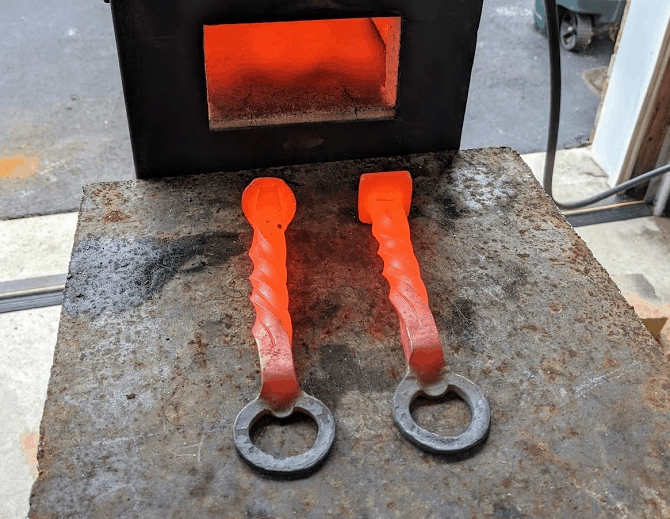So you’re looking for a new blacksmithing project and thought, “Hey, what about making a bottle cap opener out of a railroad spike?” Well, why not? I had the same thought myself, and it turned out to be such a fun project I ended up making about 20 more.
In order to forge a Railroad Spike Bottle opener, you’re going to need a few things. Get yourself a railroad spike or two, and make sure you have the tools you’ll need. In addition to an anvil and a hammer, you will need a slot punch, a ball punch, and a drift.
Now that you have all the tools you need to forge a bottle opener, let’s get started. First, we’ll go over bottle opener basics, and then I’ll show you how to spice up your openers with a few different types of decorative twists.
A handmade Railroad Spike Bottle Opener like this is a conversation starter, to say the least, and you’ll be surprised how many people will ask you to make one for them.
Bottle Opener Forging Basics
In this section, I’m going to talk about forging the opener itself. Forging your first opener is easily done using 1” x 0.5” flat stock, preferably mild steel. Save your tool steel for making tools.
Wait a minute, you said you that we were going to make a Railroad Spike bottle opener.
I did, but before you try it on a railroad spike, I think it’s important to learn how to do it on a simpler piece of metal, ergo 1” x 0.5” flat stock. So let’s continue.
Ultimately you will need about four inches of total length, however leave the metal long for now and use the parent stock as a handle. In this way, you won’t need a pair of tongs.
Personally, I think the best way to learn is to observe, so the steps for this process are listed below and below the steps is a YouTube video demonstrating the process.
6 Steps to Forge a Bottle Opener
- Punch a 0.5” to 0.75” slot in the stock ensuring that the resulting hole centered and away from the end of the material by about 5/16” of an inch.
- Use a round tapered drift to stretch the slot into a circle.
- Using the horn of the anvil, continue to develop the circle of the opener increasing the diameter of the hole while at the same time rounding the edges.
- File sharp edges as necessary.
- Forge the bottle-catch at the base of the hole.
- Forge the handle as you see fit.
Note: Steps 5 and 6 can be swapped if you are worried about damaging the catch!
Now, don’t judge too harshly about the quality of the blacksmithing in the video. This is a beginner blacksmith project done by a beginner, me. I’m learning just like you.
How to Forge a Railroad Spike Bottle Opener
Now that you’ve got the basics down and can successfully forge a normal bottle cap opener, you are ready to do it on a Railroad Spike. But first, decide on how cool you want the handle look!
Keep scrolling and check out some of the possibilities.
You can make a Pineapple twist handle with a flat bottom.
Or how about a pineapple twist handle that preserves the head of the railroad spike.
Here are a few ideas side by side. (Wait, how did that knife get in there?) 😉
Now, to forge some of the more elaborate twist patterns you are going to need another tool. For example, the pineapple twist and the cube twist both require either a hot chisel or a grinder with a cut-off wheel.
I went for the cut-off wheel in this case. It’s difficult for me to chisel straight lines. It takes a steady hand and an experienced smith to do that well. Using a grinder though was simple enough.
Instructional Videos
Like in the previous section, I have more videos showing the process for making each of the Railroad Spike Bottle Opener examples. The steps are fairly straightforward, so I’ll get to the point and embed them below. Enjoy!
Forging a Railroad Spike Blank with a flat square base.
Forging a Cube Twist in the handle of the spike.
Forging a decorative Pineapple Twist.
More Info
If you liked this project and want to see more, check out and subscribe to my YouTube channel. Besides blacksmithing, I also like working with wood, restoring tools, and I’m always up for trying something new.
While you’re there, be sure to leave a comment. I would love to hear from you.

